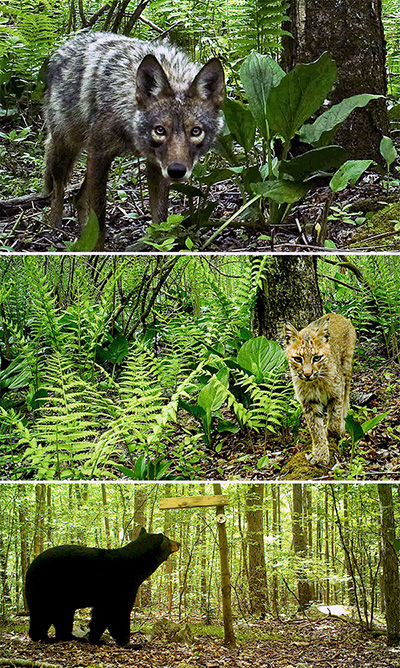Recent Headlines

From top: Wolf, Lynx, Black Bear
Smile! You’re On Canid Camera
By Karen B. Moore
If you enjoy looking at pictures of animals online, Canid Camera, a project by an ESF researcher, provides the opportunity to do that while helping improve and create habitat.
Canid Camera is a project by a post-doctoral associate, Dr. Amanda Cheeseman, a mammalogist and conservation biologist, that engages citizen scientists in identifying the animals captured on trail cameras and, in turn, could help determine the future of young forests.
"We're using trail cameras to get an idea of wildlife diversity in different types of forests, particularly young forests," said Cheeseman.
"Young forest" is the stage between an old field and a typical mature forest. "It's characterized by young and old shrubs, saplings and very dense understory," said Cheeseman. More than 100 species rely on young forests in the northeastern region of the United States but those forests are becoming increasingly rare and fragmented because of human influences. The result is a decline of many animal species.
"There's lots of wildlife and plant diversity (in young forests). They're really vibrant places. Great places for bird watching, great places for animal watching," said Cheeseman. "Those spaces have declined and with them a number of species that rely on them such as bobcats and New England cottontail rabbits."
In response to these declines, efforts to create and improve young forests are underway. However, identifying the best methods to create high-quality young forests has presented challenges to biologists and land managers, she said.
"We know it involves some sort of disturbance," she said. "Historically, young forests were created through events such as fire, blow downs, ice storms or beaver dams." However, wildfires are rare in the Northeast and, Cheeseman said, "We don't have as many beavers and we certainly don't let them create ponds like they used to so we're not getting young forests naturally and we must do that manually."
This is where Canid Camera comes in.
Taking its name from a play on the hidden camera/practical joke reality television show, Canid Camera is "looking at wildlife diversity in mature forests and young forests, and wildlife diversity within different types of managed young forests so we can try to get a better idea of what management techniques are getting the desired outcomes of wildlife diversity," Cheeseman said.
Cheeseman and her team set out numerous camera traps in the Hudson Valley area to get photos of wildlife to determine what areas they're using and not using and relate that information to forest management practices.
"What we ended up with is hundreds of thousands of photos of wildlife and some that aren't of wildlife – like moving grass – but we need to know what's in the photos and that takes a tremendous amount of effort," she said.
To help with the identification process, Cheeseman works with a web portal called Zooniverse, the world's largest citizen science web platform for people-powered research. "We thought it would be a great opportunity to engage the public in science, to publicize young forests and share the diversity within young forests with the public."
"We need the public's help," she said. "Anyone can get involved. All they need is interest and an internet connection."
Cheeseman had a team of ESF undergraduates working with her to start the project: Allison Becker, Reilly Carlson, Melissa Phillips and Jenna Holakovsky. All are students in the Department of Environmental and Forest Biology.
"I had four excellent young women who wrote most of the material on the Zooniverse and participated in providing feedback, getting the site up and running and testing the links. The whole project could not have been done without them," she said.
Cheeseman will continue to have students participate in tagging the wildlife photos, managing the social media for the project, writing newsletters and tweets, and creating other support materials to engage the public.
If a participant has a problem identifying an animal – for example telling the difference between a coyote and a gray fox - there are descriptions of the species available. And if it's still a difficult identification, Cheeseman said people should "give their best guess."
"We have a lot of different users look at each photo so we take into account all of the answers and use that to determine what is in each photo," she said. "We also have biologists tag photos as experts so we can use that as a guideline to determine how accurate the photos tagged by citizens are."
Once the photos are identified, Cheeseman and her team will look at the wildlife diversity in the different types of forest: Which species are found in mature forests, which are found in young forests? Next — within those young forests, how does the type of management affect the species populations?
"Did the young forest grow up from an old field or was it made through canopy thinning by wildlife biologists and foresters and what degree of canopy thinning did they do?" Cheeseman asked. "Did they leave trees on the ground to maybe try to deter overbrowsing by deer in these young forests?"
They'll also look at activity of predator species such as canids (a group that includes wolves, coyotes and foxes) and bobcats to see if these different management techniques lead to different activity by predators, and if that in turn impacts the survival of the New England cottontail, which is a focal species of a lot of this management.
The information will be shared with forest managers to develop best practices for creating young forests.
Canid Camera can also be found on Facebook, Twitter and Instagram.